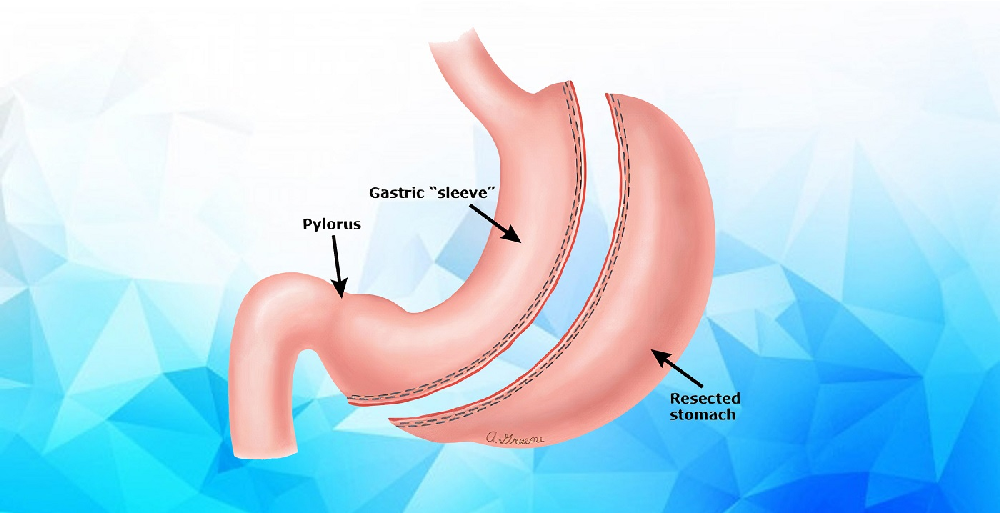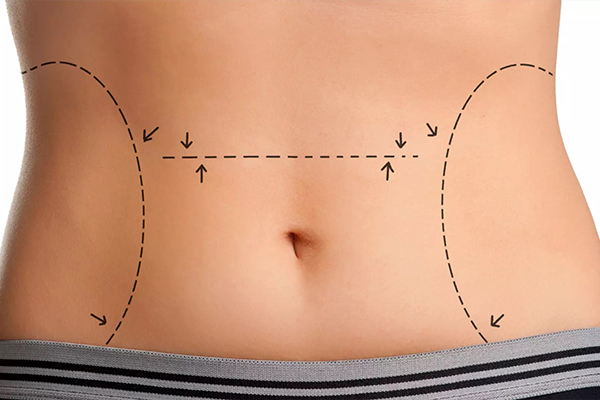What is a Gastric sleeve in Iran? Have you ever paid attention to the foods you eat? Usually, our foods are a lot of fat, carbohydrates, etc., and when we consume them, we get a huge amount of energy, and if we cannot consume or burn this energy, we will face accumulated fats that are very difficult to burn and these extra fats in our appearance. Appear and cause extreme and pathogenic obesity. Fortunately, with the advancement of medical science, bariatric surgery has been invented, which allows us to quickly get rid of accumulated body fat; One of the most common and popular bariatric surgery methods is gastric sleeve, which you will learn more about in this article.
What is a gastric sleeve?
Gastric sleeve in Iran has become a popular treatment among morbidly obese patients seeking weight loss. Gastric sleeve surgery in Iran is a surgical procedure that leads to weight loss by restricting food intake. In this procedure, which is usually performed laparoscopically, the surgeon removes about 75% of the stomach. Finally, what remains is a tubular, sleeve-like stomach that can hold much less food. This method is recommended for people with a body mass index above 40 and suffering from pear-shaped obesity. The name of this operation in English is more precisely (Gastric Sleeve Surgery) or (Vertical Sleeve Gastrectomy) and means cutting and removing a large part of the stomach. The reason why stomach shrinking is called is that after cutting and removing a large volume of the stomach, the remaining part will look like a sleeve.
Gastric sleeve in Iran is a new slimming method (slimming surgery) with minimal invasion, which reduces up to 80% of excess weight in obese people. For example, if a person is 80 kilos overweight, by performing this procedure, he can lose about 60 kilos. Also, people who perform sleeve surgery, in addition to reaching the ideal weight, achieve complete treatment or significant improvement of diseases related to obesity. A gastric sleeve in Iran is a type of surgery to shrink the stomach. In this procedure, approximately 70 to 80 percent of the stomach volume is removed in people who are severely overweight or obese. In other words, after this operation, only 20 to 30% of the original stomach remains in the abdominal cavity.

Why choose Awat Surgical clinic for gastric sleeve surgery?
We recommend you choose Awat Surgical clinic for Gastric sleeves in Iran. Because in general, we pursue 2 goals by performing weight loss surgery:
1- Reducing the volume of the stomach and food intake
2- or reducing the absorption of food by bypassing the digestive system by removing part of it
The result of both of the above cases will ultimately be weight loss. What we are looking for in Gastric sleeves in Iran are weight loss by reducing the volume of the stomach. That is, we make the patient get less food and by eating a small amount of food, he gets full quickly and automatically stops eating.
Weight loss after Gastric sleeve in Iran is expected to be between 50 and 70%. But we have patients who have lost up to 80% (and more) of their total excess weight. Almost no other method (with or without surgery) can safely lose this much weight. By looking at the weight loss table after the Gastric sleeve in Iran, you can see the weight loss process after this procedure. As can be seen from the table, the maximum amount of weight loss with sleeve surgery will be experienced in the first 6 months after the operation.
Many types of research and clinical tests have determined that the Gastric sleeve in Iran can eliminate or improve many problems related to obesity, such as:
- Type 2 diabetes, most research has shown that 80-60% of patients suffering from type 2 diabetes have improved or their disease has subsided after Gastric sleeve in Iran.
- Blood pressure disease
- Fatty liver disease
- High cholesterol
- Apnea or breathing interruption in sleep
- Reducing the risk of cancer
- Migraine
- joint’s pain
- Depression and other related mental problems
- Infertility
- Low testosterone: Gastric sleeves in Iran can naturally increase the level of testosterone.
- Involuntary urination
- Gout disease
read more: Gastric bypass surgery in Iran
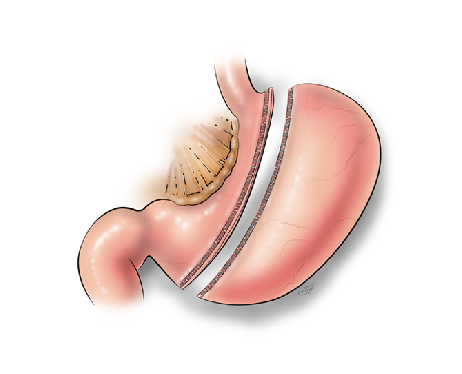
How is a Gastric sleeve surgery performed?
During Gastric sleeve in Iran, the surgeon cuts the patient’s stomach from five areas using a laparoscope. Of course, the size of these incisions is very small. Then the surgeon examines the stomach and the blood vessels move to the side of the stomach. In the next step, a tracheal tube is used as a size for the new stomach. Then, using a stapler or stapler, the stomach is completely divided into two parts. During this surgery, about 75 to 80% of the stomach is removed and a new and narrow stomach similar to the shape of a banana remains. The new banana-shaped stomach has about 20-25% of the volume of the previous stomach, it fills up faster and as a result, the person feels full sooner.
After the person enters the operating room and connects the pulse and heart rate control devices, they prepare the person for surgery by putting on an oxygen mask and injecting anesthetic within a few seconds. This surgery can be done by making a large incision in the abdomen (open procedure) or by making several small incisions and using small instruments and a camera to guide the surgery (laparoscopic procedure). In this procedure, more than half of the stomach is removed, leaving only a vertical tubular stomach the size of a banana. Then, the stomach and abdomen are stitched and closed from the cut place.
The main condition for a Gastric sleeve in Iran is to have a recommended body mass index or BMI. As mentioned above, BMI above 40 qualifies people for gastric bypass surgery. This means that instead of saying exactly what is the right weight for a Gastric sleeve in Iran, we emphasize the appropriate body mass index for the operation.

Gastric sleeve risks and complications
Any surgery, whether invasive or not, has a series of possible complications. This means that one or more complications may or may not occur for the patient. Gastric sleeve in Iran is the same and along with all the benefits it has, they may have several possible complications. Of course, the complications of this operation are minor and usually rare, and if the operation is performed by an experienced and experienced surgeon, the risk of complications is minimal or even zero. However, the following are some of the side effects of the Gastric sleeve in Iran that may or may not occur for some patients:
- hair loss
- possibility of wound infection (rare)
- Possibility of bleeding
- Occurrence of gastrointestinal symptoms such as nausea, vomiting, and diarrhea, which is known as dumping syndrome (limited).
- Gastric juice sitting at the staple line (rare)
- loss of appetite (natural)
- Failure of the stomach to return to its original state (due to removing a large part of the stomach from the abdomen)

- In order to eliminate the risk of embolism for our dear patients, we use special equipment known as DVT pomp (also known as Pneumatic pomp) and TED socks during your surgery. Also after your surgery you will get some shots of enoxaparin ampules to ensure your health (based on doctor’s diagnosis)
- Gastric sleeve surgery (known as bariatric surgery) is conducted by our surgeons which have fellowship and subspecialty in laparoscopic and bariatric surgeries
- Also, because you are a person travelling from another country to Iran with the help of a medical tourism team, you won’t need to stay in a waiting list.
- Gastric sleeve is one of the most effective bariatric surgery, resulting in a significant weight loss in people suffering from severe obesity. It is the second most common weight loss surgery.
- Attractive costs: Gastric sleeve surgery are performed in Iran at an affordable cost, compared to other countries. Depending on the doctor, hospital and clinic’s fees, and other factors, Gastric sleeve surgery costs around $2500 – $5000 in Iran (depending on surgical technique which is selected for you).
- Last but not least, we present our medical and surgical services in packages in order to support our patient and facilitate your stay in Tehran.
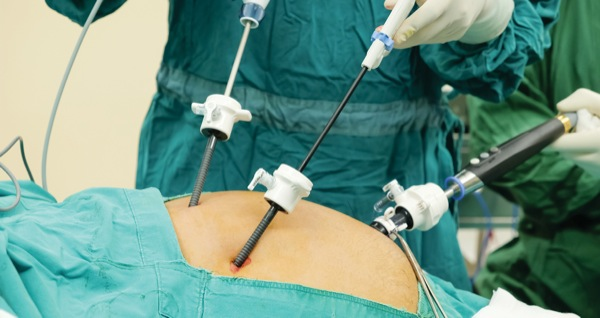
Gastric sleeve vs. gastric bypass
The basis of Gastric sleeves in Iran and many other weight loss procedures are based on the fact that by reducing the volume of the stomach in different ways, the person feels full sooner and as a result eats less food. In addition to this goal, depending on the type of slimming operation, other goals and results are also obtained from the operation. In gastric sleeve surgery, the surgeon removes most of the stomach volume and the stomach remains narrow. In this situation, the stomach only transfers food from the esophagus to the intestines, and since the volume of the stomach is now reduced, it works in an obstructive manner and makes the person full much faster than normal.
Maybe you have a question about whether sleeve surgery is better, or gastric bypass.
- Gastric sleeves in Iran are performed more than gastric bypass in recent years due to their technical ease and lower long-term side effects.
- Gastric sleeve surgery takes 40-70 minutes on average, while gastric bypass takes 2-3 hours.
- In the gastric sleeve operation, the possibility of vitamin or nutrient deficiency is much lower, and in addition, malabsorption does not occur in this operation, while one of the major problems after gastric bypass is the non-absorption of vitamins needed by the body.
- Long-term complications after gastric bypass surgery, such as intestinal blockage, marginal gastric ulcer, and internal hernia, usually rarely occur for patients who perform gastric sleeves.
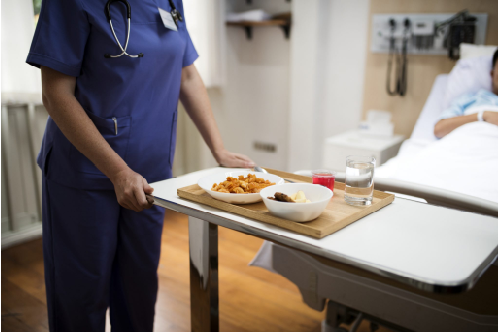
Advantages of gastric sleeve
At first glance, you might think that sleeve surgery only leads to weight loss. But this is the only primary benefit of doing this. So what are the other health benefits of Gastric sleeves in Iran?
- Reduces appetite and feeling of hunger by reducing the release of ghrelin hormone (hunger hormone)
- Because it is performed laparoscopically, it is associated with minimal invasiveness and complications
- It does not involve people in rigid dietary restrictions
- It is associated with minimal scarring
- It has the shortest recovery period
- It brings the fastest and healthiest weight loss process
- It almost cures diseases related to obesity.
Since the volume of the stomach is very small after the operation, the person feels full much faster. Hormonal changes that decrease the secretion of hunger hormones cause a person to feel less hungry. Due to the increased movements of the stomach, food passes through the stomach and intestines faster. By performing gastric sleeve surgery, on average, people lose between 60 and 70 percent of their excess weight. However, the process of weight loss in the first year of surgery is as follows:
– The first two weeks: 5 to 10 kilos, most patients daily close to 0. They lose 5 kilos.
– First trimester: 35-45% of excess weight is lost.
– The first six months: 50-60% of excess weight is lost.
– First year: 60-70% of excess body weight is lost.
Most people reach their lowest weight 12-24 months after the operation, and it is good to know that the success rate of the gastric sleeve operation is close to 80-90%.
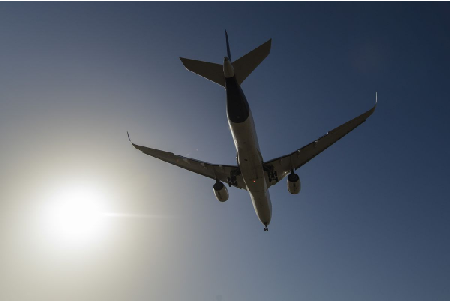
-
Preparation for Gastric sleeve surgery
Most likely, the Gastric sleeve in Iran will be scheduled for early morning. However, this depends to some extent on the surgeon’s and hospital’s schedule. Two weeks before the gastric sleeve operation, you should pay attention to the pre-surgery diet. Adherence to the preoperative diet is very important because it helps to reduce the possible risks during the operation by reducing the volume of the liver and allowing easier access to the stomach. You should fast from the night before the surgery and avoid eating and drinking. In case of eating anything, the surgery will be canceled due to the possibility of vomiting and the return of stomach contents into the lungs and blockage of the airway, because this issue can be fatal or lead to pneumonia.
The medical record is completed according to pre-operative control tests and the patient’s consent to accept possible risks and complications. The patient wears operating room clothes and removes his jewelry and accompanying objects. An open vein is taken when it is necessary to inject medicine or therapeutic serum, and then the person is transferred to the operating room.
Every obese person does not necessarily need surgery and should always try methods such as exercise and changing eating habits such as reducing the consumption of unhealthy foods, and if unsuccessful, turn to surgery. To perform sleeve surgery, the patient must first visit the doctor and get his advice, and the doctor will suggest the surgical method according to the patient’s medical records, and body mass index, and after performing numerous tests. It’s good to know that after sleeve slimming surgery, you must be in touch with a nutritionist so that after the operation, your diet plan will be adjusted in such a way that it does not cause obesity again, because people who do bariatric surgery.

Gastric sleeve surgery aftercare in Iran
Typically, for the first 5 hours after Gastric sleeve in Iran, a person will be asked to walk a few steps beside their bed to help reduce the risk of blood clots in the legs. The pain caused by gastric sleeve surgery can be very painful for some and more bearable for others. Each person experiences different levels of pain intensity and different painkillers are used for people. After sleeve surgery, it is necessary to observe the following:
- Don’t forget to take sips of fluids continuously throughout the day to prevent dehydration;
- It is normal to have difficult or painful bowel movements and constipation in the first week after the operation, which is aggravated by the use of painkillers. However, don’t hesitate to ask your surgeon for help to solve this problem;
- Painkillers should be taken only when necessary;
- Medicines prescribed to reduce stomach acidity to relieve heartburn should be taken regularly;
- Daily walking and exercise help the treatment and recovery process;
- Avoid lifting heavy objects, because it can put pressure on the stitches in the surgical area and lead to severe pain;
- Avoid sitting in the tub while bathing for 3 weeks after the operation.
As the stomach shrinks, it is very important to eat a nutritious diet. In other words, vegetables, lean protein sources, and whole grains should be included in a person’s daily diet. Diet after gastric sleeve operation:
Day 1: Fluid diet, some doctors allow patients to drink water for a few hours after surgery.
Day 2 to 14: A diet full of liquids including protein shakes, yogurt, watery soup, milk, and juice
3 to 5 weeks: bland diet
5 weeks after surgery, patients can start eating regularly.
Before & After Photos of Gastric sleeve surgery
Below, we have prepared pictures for you that show Before & After Photos of Gastric sleeves in Iran. These Photos can be good examples.



FAQ about Gastric sleeves in Iran
Gastric sleeve in Iran is not suitable for which people?
All people with a body mass index below 35 are not suitable for this procedure. Because they can lose weight with more non-invasive methods such as exercise, weight loss diet, and drug therapy.
What are the most important advantages of sleeve surgery?
Reducing more than 70% excess weight, improving health, helping to treat obesity-related diseases such as diabetes, blood pressure, and cardiovascular diseases, etc., increasing self-confidence, improving sleep, improving social and work relationships, etc. These are just a few of the most important benefits of doing this.
How much does gastric sleeve surgery cost?
Due to the complexity of the surgery and the need to use advanced equipment, the cost of the gastric sleeve operation is relatively high. However, the cost of this surgery depends on various factors.
What are the minimum and maximum ages for sleeve surgery?
This procedure can be performed at least from the age of 18 and at most up to the age of 60. Of course, in some circumstances, this range can be slightly wider. For example, when the severity of obesity is high and the diseases associated with it have made life unbearable for a person, weight loss surgery can be performed.


